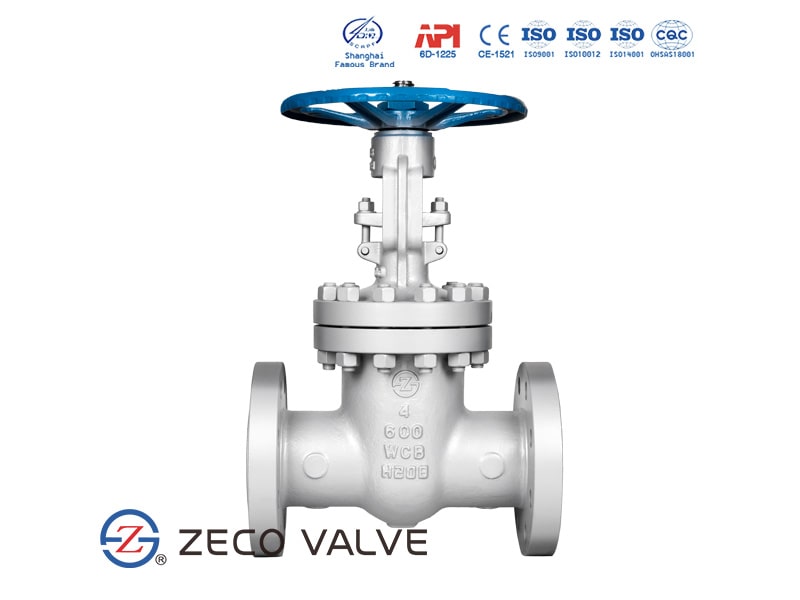HOTLINE: +840902720814

ZECO Valve is an API 600 approved Gate Valve Manufacturer.
In industrial applications, valves play a vital role in controlling or regulating media movement in piping systems. The wide scope of industrial applications allows more varieties in valve design.
While most are for the stop-start mechanism, certain valves also have throttling capabilities. Additionally, valves are either manually operated or with the use of a gear that moves the actuator.
Any person engaging in the piping business should understand the importance of valves. Knowing the operation and maintenance of valves ensures that these can last longer. It also ensures that the entire piping process is without delays.
This article discusses everything you need to know about industrial valves. Included in this article are the different valve functions and the general valve parts. This article also discusses the commonly used valves in industrial applications.
Industrial Gate Valves or “Block Valves” are the most commonly used valve type in the oil & gas industry. Gate valves are intended for on-off flow control. When fully open, fluid flows through the valve in a straight line, resulting in minimum pressure drop across the valve.
Industrial gate valves are suitable for both above-ground and underground installation and are designed for fully open or fully closed service. They are installed in pipelines as isolating valves and should not be used as control or regulating valve.
These valves can be divided into two main types, namely parallel and wedge-shaped. Parallel industrial gate valves use a flat gate between two parallel seats. The knife gate valve is a popular valve designed this way, with a sharp edge on the bottom of the gate. Wedge-shaped industrial gate valves use two inclined seats and a slightly mismatched inclined gate.
Industrial gate valves used to be a metal seated wedge with the conical wedge design and angular sealing devices needing a depression in the valve bottom to ensure a tight closure. These days resilient seated gate valves have a plain valve bottom that allows for the free passage of sand and pebbles in the valve.
Rising stems are fixed to industrial gate valves and raise or lower as the gate is operated. This is a visual indication of the industrial gate valve’s position and this makes it easier to grease the stem. This type of industrial gate valve is usually only suited to above-ground installations.
Non-rising stems are threaded into the gate itself and take up less vertical space. These valves are suitable for both above-ground and underground installations.
Industrial gate valves are long-lasting and durable and don’t require much maintenance.
| SIZE RANGE | Size Range From 1/4” – 60” |
| PRESSURE RANGE | Size Range Pressure Range ANSI 150# to ANSI 1500# pressure rating |
| MATERIAL GRADES | WCB, A105N, LF2, LCC, CF8M, 316, 316L, A20, Hastelloy C, Other exotic materials |
| TRIM MATERIALS | 13Cr, SS 316, A20, Monel, Hastelloy C stem and wedge |
| PACKAGING & GASKET MATERIAL | Graphite or Teflon |
| END CONFIGURATIONS | Raised Face, RTJ, Threaded, Socket Weld, Threaded X Socket |
| STANDARDS | Low Emissions, NACE certified |
The industrial valve is a collective set of smaller parts. There are internal and external parts. While specific valve types contain certain components definitive to that design, all industrial valves share major valve components. This section will discuss the different valve parts.
The body houses the internal parts of the valve, including the trim. This is also the passageway for the fluid. Industrial valve manufacturers produce this as either of the three: cast, forged, or fabricated. The body also connects the valve on both ends to the pipe system.
The two functions of the bonnet are:
It houses the internal parts of the valves.
It supports the stem since it is in the of the bonnet in many valve types.
The valve trim refers to the collective valve parts that come in contact with the flow media. These are the disc, the valve seat, and the stem. Take note, some valves may have additional parts, but generally speaking, these three are always present in most valves.
The type of seat and disc, along with the placement of the disc in relation to the seat, determine the valve trim performance. It is also the combination of the disc, seat, and stem that determines the movement and control of the valve.
| SIZE RANGE | Size Range From 1/4” – 60” |
| PRESSURE RANGE | Size Range Pressure Range ANSI 150# to ANSI 1500# pressure rating |
| MATERIAL GRADES | WCB, A105N, LF2, LCC, CF8M, 316, 316L, A20, Hastelloy C, Other exotic materials |
| TRIM MATERIALS | 13Cr, SS 316, A20, Monel, Hastelloy C stem and wedge |
| PACKAGING & GASKET MATERIAL | Graphite or Teflon |
| END CONFIGURATIONS | Raised Face, RTJ, Threaded, Socket Weld, Threaded X Socket |
| STANDARDS | Low Emissions, NACE certified |
ZECO Valve is an industrial valve manufacturer of ball valves, gate valves, globe valves, check valves, butterfly valves, plug valves, and strainers. Our valve factory in China adheres to ANSI, API, DIN, GOST, BS, JIS, China GB standards, and customer-specific requirements. Our products have been sold worldwide for a wide range of applications in natural gas, oil, oil refining, chemical, marine, power generation, and pipeline transportation industries.

Nhập email của bạn để nhận thông báo sớm nhất của chúng tôi
